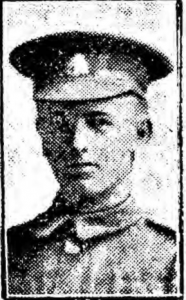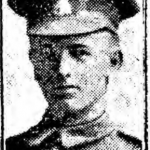
BORN COTTINGHAM 1896. ELDEST SON OF JOHN WALTER & EDITH ANNIE HALDENBY, OF 157 KING STREET, COTTINGHAM. BROTHER TO STANLEY HALDENBY. WORKED AS A GARDENER. HE ENLISTED IN HULL, ON 08/12/1915, AGED 19 YEARS AND 7 MONTHS. DESCRIBED AS 5 FOOT, 5.5 INCHES TALL, 34.5 INCH CHEST, 120 LBS WEIGHT. SENT TO FRANCE ON 14/06/1916. TRANSFERRED TO THE 8TH EAST YORKSHIRE REGIMENT. WOUNDED ON 14/07/1916 AND 28/07/1916. RETURNED TO UNIT, ON 13/09/1916. KILLED IN ACTION, AT SERRE, ON 13/11/1916, AGED 20. HE IS COMMEMORATED ON THE THIEPVAL MEMORIAL, TO THE MISSING.
Somme – The 8th East Yorkshires spent the following weeks alternating between resting, training, and spells in the line near Dickebusch, while preparations went on further south for that summer’s ‘Big Push’ (the Battle of the Somme). The battalion entrained for the Somme on the day the offensive began, 1 July. It went into brigade reserve when 3rd Division took over the Caterpillar Wood sector near Montauban, providing carrying parties and night patrols. After the disasters of the first day, 3rd Division in conjunction with three others was to make a daring night assembly and dawn attack on 13/14 July (the Battle of Bazentin Ridge). The Brigade Intelligence Officer had placed a screen of picquets and scouts out in No man’s land within 200 yards (180 m) of the enemy line and the assaulting troops slowly moved up in the hours of darkness to a sunken lane just short of this line. They then moved forwards 15 yards every 15 minutes until they were on their jumping-off tapes about 120 yards (110 m) from the enemy by 03.15; 8th EYR was on the right of 8th Bde’s line, with half of 1st Royal Fusiliers in support. At 03.20 a sudden intense bombardment was placed on the German barbed wire and trenches and five minutes later the whole attacking line of four divisions advanced behind a Creeping barrage. Along most of the line the German resistance was feeble; unfortunately the wire in front of 8th Bde was hardly touched, there were just a few breaks in the first belt and none in the second. Two platoons of the 8th EYR managed to get through on the right, the remainder had to shelter in shell holes in front of the wire or retire to the sunken road. Lieutenant-Colonel Way was wounded in the wire and Maj Brewis came up to take temporary command once more. Later a bombing party from 2nd Royal Scots came down from the left and cleared the Germans out of the trench in front of the battalion, but of the two platoons that had penetrated, no more was heard. In what was largely a successful British attack, the battalion had suffered severely, with 8 officers killed and 11 wounded, 81 other ranks killed, 218 wounded, and 141 missing, over half the initial strength of the battalion. Even when the battalion took over the opposing trenches they were heavily shelled with high explosive (HE) and gas until they were relieved on 20/21 July 1916. The success of 14 July left the British with an awkward salient south of Delville Wood, which was the scene of six more weeks’ bitter fighting (the Battle of Delville Wood). On 23 July 8th Bde held this salient round Waterlot Farm while the rest of the division attacked Delville Wood. The brigade’s contribution to the attack was to send out two strong bombing parties from 7th King’s Shropshire Light Infantry (KSLI), supported by a company of 8th EYR, trying to clear along the railway towards Guillemont station and widen the salient. They made little progress and fell back to Waterlot Farm, their attack having been disrupted by another division falling back from an attack on Guillemont. 8th East Yorkshires’ companies were now down to a strength of 40–50 each, but a draft of 320 reinforcements (from the Green Howards and the York and Lancaster Regiment) arrived that day. When relieved on 25 July the battalion consisted of 20 officers and 570 other ranks.
3rd Division went back into the line for a new attack on Guillemont on 17 August. Next day 8th EYR was loaned to 9th Bde for an attack during which the battalion bombers and B Company gained a footing in the German trenches but had to retire when the battalions on either side failed to get in. When it left the line on 20 August the battalion had suffered a further 6 officers wounded, 34 other ranks killed, 31 wounded and 46 missing. At the end of the month 8th EYR was holding trenches in the Hulluch sector and between 21 September and 5 October 3 Division underwent training before moving back to the Somme.
The last phase of the Somme offensive was the Battle of the Ancre on 13 November, a final attempt to secure better ground and observation points for the winter. 3rd Division’s task was to repeat the attack on the village of Serre that had failed on the first day of the offensive, though this time it would be supported by twice as many guns. 8th Brigade attacked on the right with 8th EYR in the second line. The attacking battalions struggled through mud that was at times waist-deep, and got left behind by their protective creeping barrage. In the second line 8th EYR had the furthest to go, across 1,000 yards (910 m) of broken trench bridges and shell-torn ground before they reached the front. As they filed forwards, the German counter-barrage caught D Company coming up the rear. The battalion then followed the leading wave. Both waves struggled through gaps in the wire and across the German front line. Parties of all four battalions of 8th Bde reached the German support line, but could not maintain themselves there; others got mixed up in the confusion at the German front line. The whole mass of men was tumbled back to where they started. Zero hour had been at 05.45; by 06.30 it was clear at Brigade HQ that the battle was over. In the words of the Official History: ‘the troops of the 3rd Division … lost the battle in the mud’. 8th East Yorkshires had lost 2 officers killed and 3 wounded, 23 other ranks killed, 177 wounded and 30 missing.
